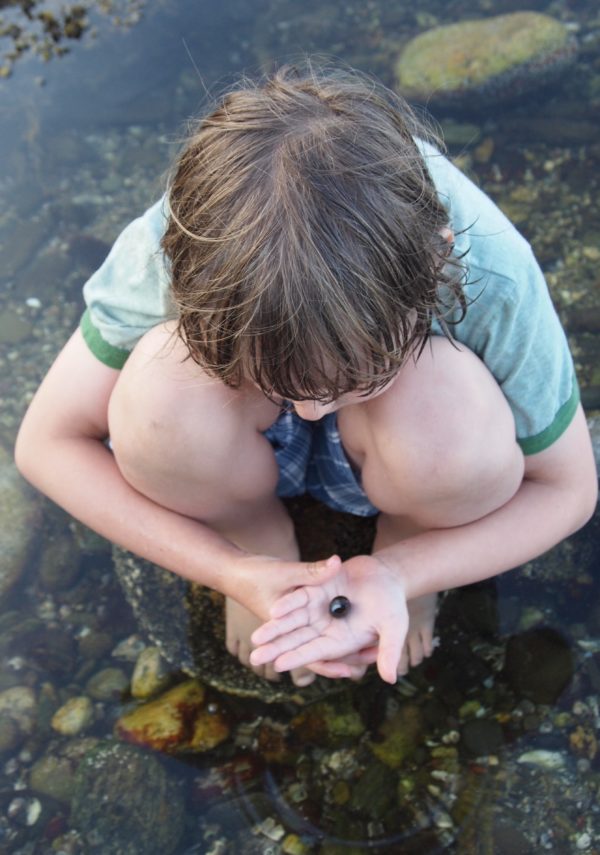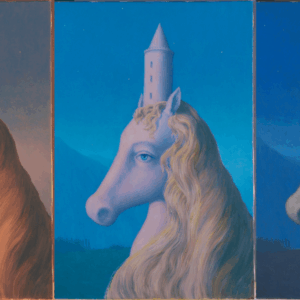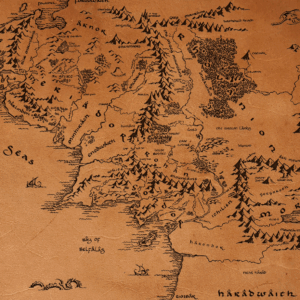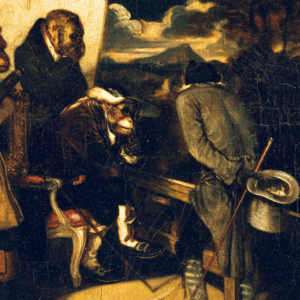
Small Wonder: The Challenge of Parenting Through Climate Collapse
Eiren Caffall on Rereading Rachel Carson and Exploring the Tidepools of Maine
We come to Monhegan Island—twelve miles off the coast of Maine, perched in the fastest-warming saltwater ecosystem on the planet—to avoid darkness. We come for wonder.
We walk across the island once we’ve dropped our bags in our rooms, my son Dex and I, past the brewery newly-built for the summer trade, past the bluff where Rockwell Kent owned the white cottage whose porch still faces into the sunrise. We find our way through Lobster Cove with the duck family that comes back every year to breed, over the high rocks, the wooden cross holding up a circular life preserver as an odd talisman against the waves that sometimes take this coast. We snake through stunted pine trees and mosses, katydids flying out in front of our feet, and come at last to our tidepools.
Monhegan has the trick of appearing pristine, surrounded though it is by that warming ocean. It is a gentle place to engage in wonder, a good companion to the fear and dread that dogs each step in this era of collapse. On Monhegan, we repeat a yearly ritual—encountering the island with the joy that Rachel Carson, who lived just down the coast in Southport, Maine, advocated teaching children in her book The Sense of Wonder.
Monhegan’s pools are only relatively rich—mostly in barnacles and mussels, sometimes a starfish, sometime an urchin—and covered in common periwinkles. But they are a scale we can handle: little, surrounded by flat rocks where one can spend an afternoon with a book and a sun hat and a sandwich, where a child with a bucket is the richest person on earth.
*
Rachel Carson wrote books about the regions where land meets sea long before she became famous as the prophet of the modern environmental movement with the publication of Silent Spring. Her early works were lyrical meditations on the tidepools of Maine and the oceans everywhere. She had a gift for bringing people into alien landscapes and serving as their guide. In The Edge of the Sea and The Sea Around Us she took readers by the hand and showed them beauty, ecosystems that were in health, with mollusks and algae and fish and seaweed. She revealed complexity as harmony. Many of her early readers balked at the stern warnings that laced Silent Spring. But, for Carson, there wasn’t much difference between enumerating beauty and enumerating threat. When you saw the wonder in something, her books imply, you would naturally want to preserve it. Her last book, The Sense of Wonder, remained unpublished at the time of her death. It epitomizes that assumption and remains more important to me than the book that changed the world.
The averageness of the miracles on the island is what makes the place sacred to us.
The Sense of Wonder is about cultivating awe in nature and teaching others to do the same, especially children. “If I had influence with the good fairy who is supposed to preside over the christening of all children,” Carson wrote, “I should ask that her gift to each child in the world would be a sense of wonder so indestructible that it would last throughout life, as an unfailing antidote against the boredom and disenchantment of later years, the sterile preoccupation with things that are artificial, the alienation from the sources of our strength. If a child is to keep alive his inborn sense of wonder without such a gift from the fairies, he needs the companionship of at least one adult who can share it, rediscovering with him the joy, excitement, and mystery of the world we live in.”
This is the project of my days at the tidepools with Dex.
*
It was at Monhegan’s tidepools that Dex and I learned to sing to periwinkles. If you pull them from the water they will tuck their feet inside their shells. But as they warm in the sunshine, they begin to reach out and explore. If, at that moment, you sing Periwinkle, Periwinkle open your eye, Periwinkle, Periwinkle, don’t be shy, they will come out even further. The tourist who taught us the song five years ago was no more a scientist than I am, but she made a convincing case. “The vibrations from your voice,” she said, “or maybe the air from your mouth, it makes them curious.”
If you have found a brave snail, the foot will extend and the creature will reach and reach, touching your rough thumb with its foot, then extending further until its eyestalks emerge into the sunlight, and, looking like they might be blinking, they seem to regard you and your strange music with skepticism. It is a Beatrix Potter trick of imagination and tune. It is a miracle.
The averageness of the miracles on the island is what makes the place sacred to us. The regularity of mist in the pine forests, tourist voices on the cliffs, brave snails—those things give it heft, gravitas, especially for city dwellers like us, not islanders, especially for two people in love with nature and terrified for it, aware of daily losses and enraptured still by mystery. It is the truest place I ever stand with my son. And for him, it is the place he returns to every year, an axis on which pivots his joy.
The center of that centering place is always the tidepools and the creatures he finds in them, along with he has assumed of telling the tourists what can be found in the inlets of Lobster Cove, in the clefts between the rocks, in the silent places where the mussels and the barnacles grow.
He’ll lead someone, usually an adult, to the break in the long, coarse gabbro and basalt rocks, kneel down on their hot grey surface, and point. “See,” he’ll tell them, “there are the barnacles.” One year, when he was seven, a woman, done with his eager manner, tried to stand up too soon. “Wait,” he told her, “if you watch closely, you can see them eating.”
When the woman saw it, she looked at him with an open wonder in her eyes, caught from him, from the tiny grace of seeing a familiar creature in a way she had never seen it before. Dex looked at her then. “Did you know that the ocean is acidifying?” he asked. She blinked—the wonder disrupted—and shook her head. “I wish I knew what the barnacles will do,” he said, and led her off beyond my hearing to see more beauty.
*
For people who casually spend time on the coast of the Atlantic, periwinkle snails seem a common, homely creature, as familiar as the sound of the waves. There are three varieties on the Atlantic coast. Two are native, the smooth and the rough periwinkles. The smooth prefers the sea, the rough the land. But the most plentiful on the eastern seaboard is the common periwinkle, Littorina littorea, straddling the worlds of land and sea.
I am trying to stay alive to feelings in the era of collapse. I am trying to understand my own, parent my child through his.
The common periwinkle is an invader, having arrived back in the colonial era. Used as food in Europe, periwinkles may have been brought to the colonies as an easy source of protein. They also may have arrived, as many ocean invasives do, in the ballast of ships, and in particular on ballast rocks that weighed down empty holds until cargo was traded for stones.
Where they live in the intertidal zone, common periwinkles can be submerged or semi-terrestrial. They lay their eggs in the sea, though and hover in those spaces at play in the tides, bathed by the rhythm of the ocean. They eat algae—grazing over rocks, consuming the coating of plant matter that covers them, changing the nature of the ecosystem, stripping rocks bare, revealing their gray surfaces. They have no natural predators to slow their destruction of ecosystemic balance. They eat barnacle larvae, disrupt diatoms—a planktonic anchor of the marine food web—and their grazing mechanism, the tongue-like radula, works its 3,200 chitinous teeth across the rocks relentlessly, an army of snails eroding the coastline alongside the wind and water. They feed in marshlands, and break the stalks of codgrass until those wetland anchors die, destroying the foundations of salt marshes all along the coast. They edge out the native snails. In the Gulf of Maine—warming 90 percent faster than the rest of the planet’s oceans—those changes only exacerbate collapse.
In an ecosystem facing such disaster, what is the place of wonder?
*
Rabbi Joshua Heschel says in his book Man is Not Alone, “Wonder is a state of mind in which … nothing is taken for granted … Each thing is a surprise, being is unbelievable. We are amazed at seeing anything at all; amazed not only at particular values and things but at the unexpectedness of being as such, at the fact that there is any being at all.”
I am still in awe that the world endures, survives, even broken, in the face of all we’ve done to it. But I understand the urge to look only at the end we face, and not at the amazement. I see the periwinkle as the harbinger of coastal destruction; I hate it for the ruin of the marshes, to fear the slow work of its radula on the rocks and algae. As I attempt to hold on to wonder, I spend time in fear or anger, panic or denial, looking at the complex unraveling of the world I love.

I have faced this in my own body. I was born with a genetic kidney disease, polycystic kidney disease (PKD) that killed most of my family before they turned 50. I was diagnosed when I was 22, and told I’d never have children, that I’d lose my kidney function before 30, that I was dying, flooding from within like the long line of my family. I have come to see my illness as mirroring environmental collapse—invisible until it isn’t, generational, a feedback loop of horror that must be faced and survived, even though there is no cure.
There are days when I hate my kidneys for all they’ve done to me, when I mourn my DNA and all it has taken from my family, when I fear the future of Dex’s health written in his DNA. As I wait in the mystery of our future, it is tempting to spend time in dread.
Instead, I try to lean into the wonder that he exists at all, and the wonder that I do as well. And in the grip of that wonder, I go out into the world with him, I spend time beside the tidepools.
*
As Carson said in The Sense of Wonder, “I sincerely believe that for the child, and for the parent seeking to guide him, it is not half so important to know as to feel. If facts are the seeds that later produce knowledge and wisdom, then the emotions and impressions of the senses are the fertile soil in which the seeds must grow.”
I am trying to stay alive to feelings in the era of collapse. I am trying to understand my own, parent my child through his.
Without emotional flexibility, we will not be able to fight our way through the era of collapse.
When I think of the losses that are coming for Monhegan, the wonder that I’ve cultivated on its shores feels hollow. The water grows higher and warmer every year, threatening inundation. Those tidepools are destined to fall beneath the waves before the cliffs do. Monhegan rests in Muscongus Bay, caught in the complex specificity of the Gulf of Maine’s geomorphology and relationship to Atlantic currents. The water grows sicker each year, its chemistry and balance and biodiversity shifting with the shifts of the whole world.
With this in mind, it is impossible to sit by the water with a book in hand, watching a child collect snails, as if there is not a collapse unfolding on your watch. It is impossible to rely on wonder alone. It is like living in a body that is shifting under your own skin, out of balance and beyond the control you thought you had. It is as impossible as knowing your life is in danger from a genetic disease and pretending that it is not.
It isn’t enough to just love the periwinkles and find joy in their magic; we have to see them clearly if we want to heal the coast of Maine. Wonder is only a step away from denial. We are all in wonder and dread at the same time, spiraling through all those feelings. Without emotional flexibility, we will not be able to fight our way through the era of collapse. Awash in dread alone, without the influence of wonder, nature would no longer provide me solace from my fear. Enraptured by wonder alone, shut down to the crisis, I would not be part of the fight to heal the world.
Do I hate periwinkles because they are destroying the marsh grasses? I feel their wonder and I also see them with dread. Do I hate my kidneys because they are destroying my health? I wonder every day that they are still working, and I dread what they could do. I can’t forget either side of the story. None of us should.
We should take strangers by the hand, stand with them in awe of what we have, and plan what we’ll do to make sure that it exists at all.
Eiren Caffall
Eiren Caffall is a writer and musician whose work has appeared in Guernica, The Los Angeles Review of Books, Al Jazeera, The Rumpus, and on three record albums. She is the recipient of a Whiting Foundation Creative Nonfiction Grant and a Social Justice News Nexus fellowship at Northwestern University, among other awards. The author of a memoir, The Mourner’s Bestiary (2024), she lives in Chicago with her family. All the Water in the World is her first novel.












